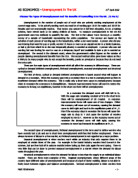“Define and determine the types and trends of UK unemployment”
Unemployment is when individuals are jobless but are willing and able to work at the going wage rate. The official government figures only count those that are registered as being unemployed and are actively seeking work.
Different Measures of Unemployment
There are several different measures of unemployment:
- ILO – Any person without a job, available to work, willing to work and sought work in the past four weeks
- Labour Force Survey (LFS) – Available to work within the next two weeks, currently without work, but have sought work in the past four weeks
- The Claimant Count – This measures the number of people who are eligible and claim the Job Seekers’ Allowance, as such, this method generally records fewer unemployed (around 400,000)
From these figures is it possible to calculate the Unemployment Rate:
Number of unemployed/number of economically active x 100
Types of Unemployment
There are many different types and causes for unemployment:
- Real wage unemployment: This is thought to be the result of wages being above the market clearing level, leading to an excess supply of labour. It is thought that national minimum wages can cause wage unemployment because the employees feel that the work is not worth the minimum amount.
- Demand deficient unemployment: This is usually associated during a period of recession in the business cycle. This is because during recessions aggregate demand is low and so firms are more likely to become bankrupt as well as lay-off of employees.
- Frictional unemployment: This is transitional unemployment due to people moving between jobs: For example, newly redundant workers or workers entering the labour market may take time to find appropriate jobs at wage rates they are prepared to accept. Many are unemployed for a short time whilst involved in job search. Imperfect information in the labour market may make frictional unemployment worse if the jobless are unaware of the available employment opportunities.
- Structural unemployment: This occurs when people are made unemployed because of capital-labour substitution (which reduces the demand for labour) or when there is a long run decline in demand in their particular industry. Structural unemployment exists where there is a mismatch between their skills and the requirements of the new job opportunities. Many of the unemployed from heavy manufacturing industry (e.g. in coal, steel and heavy engineering) have found it difficult to gain re-employment without an investment in re-training. This problem is one of occupational immobility.
- Hidden unemployment: This is when unemployed people are interested in taking part in work, but currently not classified as unemployed. This may be because they have been unemployed for so long that they have lost all motivation for searching for work or they may have lost their skills requires.

This is a preview of the whole essay
Peer Reviews
Here's what a star student thought of this essay
Quality of writing
There isn't much to structure here, as this is more of an overview and revision sheet than an argument. Bullet points are used well to differentiate between points, and technical terms are used throughout. Spelling, punctuation and grammar are fine.
Level of analysis
The analysis in here is sound. I liked the definition of unemployment, as this is a popular question and often the definition is confused. You must put "willing and seeking work" and this essay does this well. I would note that exams often like to catch people out by asking you to define the unemployment rate, this is as simple as quoting the definition and then adding the formula given in this essay! The types of unemployment are given a good overview, however I would've liked to have seen some diagrams showing shifts in aggregate demand, etc. Diagrammatical analysis is an easy way to pick up marks, as it shows a variety of skills and a strong understanding of what causes unemployment. The discussion of NAIRU is strong, as this is a concept which is commonly forgotten about or misunderstood. When talking about the costs of unemployment, it would be good if a PPF was included as this shows the misallocation of resources and waste of capacity. I always like to talk about the costs to the unemployed, as this can bring social problems. Hysteresis is a concept which examiners like, whereby the long term unemployed lose any skills or confidence making it harder for them to find work. As mentioned above, when talking about policies you really need to be clearer and discuss monetary and fiscal approaches.
Response to question
I liked this essay as it gives a good overview of unemployment, without getting bogged down in argument. This should be a good resource to look at for revision. The definition of unemployment is covered, the types are summarised, the costs are covered. The policies to reduce unemployment is poorly covered, however, as this should be looking at fiscal and monetary policies also. Trends are briefly looked at, but if you are preparing for an exam it would be wise to look at more recent data.







